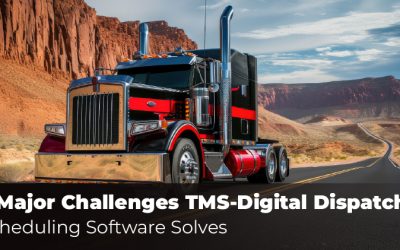
Transportation is a vital component of the global economy, and efficient transportation operations management is crucial for businesses to remain competitive. Transportation Management System (TMS) Dispatch solutions are critical in the transportation industry, helping companies to manage their fleets, dispatch drivers, and track deliveries.
TMS Dispatch solutions help improve the efficiency of transportation operations, reduce costs, and enhance customer satisfaction. However, with several types of TMS Dispatch solutions available, it can take time to determine which is best for your business.
This blog post will explain the different types of TMS Dispatch solutions available, their advantages and disadvantages, and the factors to consider when choosing the right solution. Also, we will provide best practices for implementing TMS Dispatch solutions and offer insights on how they can benefit your business. By the end of this post, you will better understand the different types TMS Dispatch solutions and be able to make an informed decision on which one is right for your business.
What is TMS Dispatch?
Transportation Management System (TMS) Dispatch is a software solution enabling businesses to manage their operations effectively. It is a critical TMS system component, including planning, execution, and analytics capabilities. TMS Dispatch solutions help companies to manage their fleets, dispatch drivers, and track deliveries, providing visibility and control over transportation operations.
It allows dispatchers to assign drivers to loads, manage routing and scheduling, and communicate with drivers in real time. It also helps businesses optimize their transportation operations, improve customer service, and reduce costs associated with transportation. TMS Dispatch solutions provide various features, such as automated scheduling, GPS tracking, driver management, and load optimization, making transportation operations more efficient.
Dispatch solutions come in different types, including manual, automated, and hybrid. Choosing the right type of Dispatch solution depends on the size and complexity of your fleet, the types of goods being transported, customer requirements and expectations, and budget and cost considerations.
Types of Dispatch Solutions
There are three main types of TMS Dispatch solutions: manual, automated, and hybrid dispatch. Let’s take a closer look at each type:
-
Manual Dispatch:
Manual dispatch is the most traditional form of TMS Dispatch solution, where dispatchers manually assign drivers to loads and manage scheduling and routing. Dispatchers use phone, email, or fax to communicate with drivers and track delivery status. Manual dispatch is still widely used by smaller fleets or businesses with less complex transportation operations.
Advantages:
– Simple and easy to use
– Low cost, as it requires minimal technology investment
Disadvantages:
– Time-consuming and prone to human errors
– Limited visibility into transportation operations
– Inefficient for large and complex fleets
-
Automated Dispatch:
Automated dispatch is a TMS Dispatch solution that uses technology to automatically assign drivers to loads, manage routing and scheduling, and communicate with drivers in real time. Automated dispatch uses GPS tracking, electronic communication, and data analysis to optimize transportation operations. Automated dispatch suits businesses with larger fleets and more complex transportation operations.
Advantages:
– Efficient and reduces human errors
– Provides real-time visibility into transportation operations
– Optimizes transportation operations and reduces costs
Disadvantages:
– Higher initial investment in technology
– Requires ongoing maintenance and updates
– May require changes to existing processes and operations
-
Hybrid Dispatch:
Hybrid dispatch is a combination of manual and automated dispatch. It uses technology to automate certain aspects of dispatch, such as load optimization and routing, while allowing dispatchers to manage other tasks manually. Hybrid dispatch suits businesses with medium-sized fleets or those transitioning from manual to automated dispatch.
Advantages:
– Provides a balance between manual and automated dispatch
– Allows for flexibility in managing transportation operations
– Reduces human errors and optimizes transportation operations
Disadvantages:
– Requires investment in technology
– May require additional training for dispatchers
– May not provide the full benefits of automated dispatch
Factors to Consider When Choosing a Dispatch Solution
Choosing the right TMS Dispatch solution for your business can be challenging. To help you make an informed decision, consider the following factors:
- Fleet Size and Complexity: The size and complexity of your fleet will determine the type of TMS Dispatch solution suitable for your business. If you have a small fleet, manual dispatch may be sufficient, but automated or hybrid dispatch may be necessary for larger and more complex fleets.
- Transportation Operations: Consider the types of goods you transport, the routes you take, and the delivery requirements of your customers. The TMS Dispatch solution you choose should be able to accommodate these factors and optimize transportation operations accordingly.
- Customer Service: Your TMS Dispatch solution should provide real-time visibility into delivery status, enable efficient communication with drivers, and provide accurate estimated delivery times. This will help you improve customer service and meet customer expectations.
- Cost: Consider implementing and maintaining the TMS Dispatch solution. Manual dispatch is the most cost-effective option, but it may provide a different level of efficiency and optimization than automated or hybrid dispatch.
- Integration: Your TMS Dispatch solution should integrate seamlessly with your existing systems and processes, such as your TMS planning and execution modules, to ensure smooth operations and minimize disruptions.
- Training and Support: Ensure that the TMS Dispatch solution you choose has adequate training and support to ensure smooth implementation and ongoing maintenance.
Best Practices for Implementing Dispatch Solutions
Implementing a TMS Dispatch solution can be a significant undertaking for any business. To ensure a successful implementation, here are some best practices to consider:
- Set Clear Goals and Objectives: Define clear goals and objectives before implementing a TMS Dispatch solution. What do you want to achieve with the solution? What metrics will you use to measure success? Setting clear goals and objectives will help you stay focused and on track during implementation.
- Involve Stakeholders: Involve stakeholders from across the organization in the implementation process, including dispatchers, drivers, IT staff, and management. This will ensure that the solution meets the needs of all stakeholders and will increase buy-in and adoption.
- Plan for Change Management: Implementing a TMS Dispatch solution will likely require existing processes and operations changes. Plan for change management by communicating the changes to stakeholders, providing training and support, and addressing concerns and feedback throughout the implementation process.
- Choose the Right Implementation Team: Choose an implementation team with the expertise and experience to successfully implement the solution. The team should include individuals from IT, dispatch, and other relevant departments.
- Test the Solution: Test the TMS Dispatch solution thoroughly before going live to ensure it meets your business needs and works as expected. This includes testing features like load optimization, routing, driver communication, and reporting.
- Monitor and Evaluate Performance: Once the solution is live, monitor and evaluate its performance regularly to ensure it meets your goals and objectives. Use the metrics defined during goal setting to measure success and identify areas for improvement.
Choose the Right Dispatch for Your Business
Implementing a TMS Dispatch solution can help your business improve efficiency, reduce costs, and provide better customer service. Considering the fleet size, transportation operations, price, integration, and training and support, you can choose a solution that meets your business needs.
At TMS-Digital, our Dispatch solution offers a comprehensive and flexible solution to manage your dispatching operations. With features such as real-time visibility, load optimization, automated routing, and communication with drivers, our solution can help you streamline your dispatching process and achieve better outcomes. Additionally, our solution integrates seamlessly with your existing TMS planning and execution modules, minimizing disruptions to your operations.
Contact us today to learn how Dispatch by TMS-Digital can help your business succeed.










